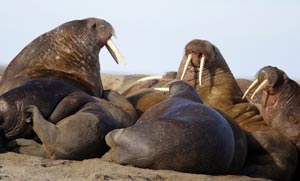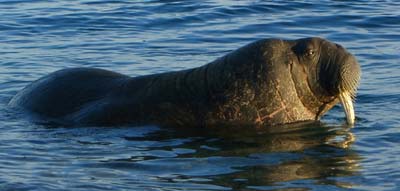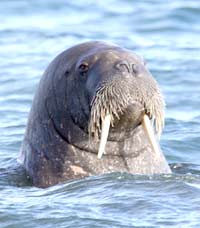|
 Enormous gelatinous masses: Walruses are large semi-aquatic mammals that live in the cold Arctic seas of the Northern Hemisphere. Two subspecies exist: the Atlantic, Odobenus rosmarus rosmarus, and the Pacific, Odobenus rosmarus divergens. The Pacific walrus is slightly larger, the male weighing up to 1800kg (4000lbs), but usually males only top out at 3500 lbs. Walruses should not be confused with elephant seal.
Walruses have thick skin and it can get to 5cm (2in) thick around the neck and shoulders of males. Enormous gelatinous masses: Walruses are large semi-aquatic mammals that live in the cold Arctic seas of the Northern Hemisphere. Two subspecies exist: the Atlantic, Odobenus rosmarus rosmarus, and the Pacific, Odobenus rosmarus divergens. The Pacific walrus is slightly larger, the male weighing up to 1800kg (4000lbs), but usually males only top out at 3500 lbs. Walruses should not be confused with elephant seal.
Walruses have thick skin and it can get to 5cm (2in) thick around the neck and shoulders of males.


Half water, half land: Walruses spend about half their time in the water and half their time beaches or ice floes, where they gather in large herds. They may spend several days at a time either on land or in the sea. Diving to depths of 90 m (300 ft), they sometimes stay under for as long as a half hour. They use their pectoral flippers to move along out of water and can stand on all fours with an awkward gait when on rough surfaces.

30 minute dives: Walruses mate in the water and give birth on land or ice floes. They feed in the water, diving to depths of 300 ft (90 m), sometimes staying under for as long as a half hour. Clams and mollusks form a large part of their diet. Male walruses compete for territory, often fighting each other; the winners in these fights breed with large numbers of females. Older male walruses frequently bear large scars from these bloody but rarely fatal battles. Walruses have been known to kill polar bears.
Famous tusks: The walruses use their long tusks (elongated canines) for fighting, dominance, and display and the males will spar with their tusks. They can also use them to form and maintain holes in the ice, or to anchor themselves with the ice.

Pack ice birth: Walruses have a breeding season in mid-winter, a time spent in the southern Bering sea. The males show off in the water for the females who view them from pack ice. Males compete with each other aggressively for this display-space. Mating probably takes place in the water. After fertilization the fertilized egg remains dormant for several months, then a gestation period of 11 months follows. When a calf is born it is over 3 ft (1 m) long and able to swim. Birth takes place on the pack ice; the calf nurses for about 2 years, spending 3 to 5 years with its mother. Females mature at about 6 years, males at 9 or 10. A walrus lives about 50 years.

 3 Natural Enemies: About 200,000 Pacific walruses exist; Alaska Natives harvest about 3000 annually. The walruses use their long tusks (elongated canines) for fighting and for display. Humans use ivory from the tusks for carving. The natives call the penis bone of male an oosik and use it in making knives. Walruses have only three natural enemies: humans, orca, and the polar bear. Polar bears hunt walruses by rushing at them, trying to get the herd to flee, then picking off calves or other stragglers. 3 Natural Enemies: About 200,000 Pacific walruses exist; Alaska Natives harvest about 3000 annually. The walruses use their long tusks (elongated canines) for fighting and for display. Humans use ivory from the tusks for carving. The natives call the penis bone of male an oosik and use it in making knives. Walruses have only three natural enemies: humans, orca, and the polar bear. Polar bears hunt walruses by rushing at them, trying to get the herd to flee, then picking off calves or other stragglers.
Protecing the walrus: Federal laws in both the USA and in Canada protect walruses and set quotas on the yearly harvest. Only under rare circumstances may non-native hunters gain permission to kill a walrus legally. The law prohibits the export of raw tusks from Alaska, but walrus-ivory products may come on the market if first sculpted into scrimshaw by a native craftsman. Commercial auction sites such as eBay make a large selection of "pre-ban" walrus ivory available.
About 15,000 Atlantic walruses exist: they live in the Canadian Arctic, in the waters of Greenland, of Svalbard and of the western portion of the Russian Arctic. The Atlantic walrus once enjoyed a range that extended south to Cape Cod and occurred in large numbers in the Gulf of St. Lawrence.
All text is available under the terms
of the GNU Free Documentation License
|